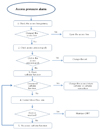Abstract
Purpose
This study was done to develop a schematized alarm-managing manual for continuous renal replacement therapy (CRRT) and to investigate its effects in maintaining continuity in the patients' treatment and promptly resolving alarms when CRRT is being carried out.
Methods
Sixtynurses from two medical intensive care units (ICUs) (one experimental and one control) at one hospital were asked to answer a questionnaire including their CRRT nursing competency and satisfaction with the manual. Data on alarm resolution rate were collected by analyzing existing data, such as the details of each alarm and the number of resolutions around the clock in the CRRT device.
Figures and Tables
Table 1
General and CRRT-related Characteristics of Participants and Homogeneity of Two Groups (N=60)

References
1. Tonelli M, Manns B, Feller-Kopman D. Acute renal failure in the intensive care unit: A systematic review of the impact of dialytic modality on mortality and renal recovery. Am J Kidney Dis. 2002; 40(5):875–885. http://dx.doi.org/10.1053/ajkd.2002.36318.
2. Dirkes SM. Continuous renal replacement therapy: Dialytic therapy for acute renal failure in intensive care. Nephrol Nurs J. 2000; 27(6):581–590. quiz 591-592.
3. Baldwin I, Fealy N. Clinical nursing for the application of continuous renal replacement therapy in the intensive care unit. Semin Dial. 2009; 22(2):189–193. http://dx.doi.org/10.1111/j.1525-139X.2008.00547.x.
4. Guenoun T, Journois D, Safran D. [Hemofiltration during severe sepsis or multiorgan failure syndrome]. Nephrologie. 1998; 19(2):83–88.
5. Seo JW, Park JS. Continuous renal replacement therapy. Korean J Crit Care Med. 2001; 16(2):115–118.
6. Bellomo R, Baldwin I, Golpe T, Ronco C. Trouble-shooting during CRRT: Clinical and technical problems. In : Bellomo R, editor. Atlas of hemofiltration. London: Saunders;2001. p. 69–76.
7. Baldwin I. Is there a need for a nurse emergency team for continuous renal replacement therapy? Contrib Nephrol. 2007; 156:191–196. http://dx.doi.org/10.1159/0000102083.
8. Ricci Z, Ronco C. Information technology for CRRT and dose delivery calculator. Contrib Nephrol. 2007; 156:197–202. http://dx.doi.org/10.1159/0000102084.
9. Baldwin I, Elderkin T, Bridge N. Nursing management concepts for CRRT in the ICU. In : Bellomo R, editor. Atlas of hemofiltration. New York: Saunders;2001. p. 83–95.
10. Berbece AN, Richardson RM. Sustained low-efficiency dialysis in the ICU: Cost, anticoagulation, and solute removal. Kidney Int. 2006; 70(5):963–968. http://dx.doi.org/10.1038/sj.ki.5001700.
11. Mulder J, Tan HK, Bellomo R, Silvester W. Platelet loss across the hemofilter during continuous hemofiltration. Int J Artif Organs. 2003; 26(10):906–912.
12. Bellomo R, Baldwin I, Fealy N. Prolonged intermittent renal replacement therapy in the intensive care unit. Crit Care Resusc. 2002; 4(4):281–290.
13. Graham P, Lischer E. Nursing issues in renal replacement therapy: organization, manpower assessment, competency evaluation and quality improvement processes. Semin Dial. 2011; 24(2):183–187. http://dx.doi.org/10.1111/j.1525-139X.2011.00835.x.
14. Dirkes S, Hodge K. Continuous renal replacement therapy in the adult intensive care unit: history and current trends. Critical Care Nurse. 2007; 27(2):61–80.
15. De Becker W. Starting up a continuous renal replacement therapy program on ICU. Contrib Nephrol. 2007; 156:185–190. http://dx.doi.org/10.1159/0000102082.
16. Gambro. Prisma Flex operator manual. Seoul: Gambro;2009. p. 103–161.
17. Lee SJ. Quality improvement in continuous renal replacement therapy. J Korean Soc Qual Assur Health Care. 2009; 2:101–103.
18. Kim HE. Development and evaluation of the web-based CRRT nursing education program [master's thesis]. Busan: Pusan National University;2012.
19. Langford S, Slivar S, Tucker SM, Bourbonnais FF. Exploring CRRT practices in ICU: A survey of Canadian hospitals. Dynamics. 2008; 19(1):18–23.
20. Park MH. Understanding and application of evidence based nursing. Seoul: Koonja Publishing;2006. p. 145–147.
21. Paul S. Developing practice protocols for advanced practice nursing. AACN Clinical Issues. 1999; 10(3):343–355.
22. Irons LR, Keel R, Bielema CL. Blended learning and learner satisfaction: Keys to user acceptance? USDLA J. 2002; 16(12):29–39.
23. Vijayan A. Vascular access for continuous renal replacement therapy. Semin Dial. 2009; 22(2):133–136.
24. Baldwin IC. Training, management, and credentialing for CRRT in the ICU. Am J Kidney Dis. 1997; 30(5):112–116.
25. Huang YC, Hsu LL. Critical care nurse learning of continuous renal replacement therapy: The efficacy of a self-learning manual. Hu Li Za Zhi. 2011; 58(1):37–47.
26. Mottes T, Owens T, Niedner M, Juno J, Shanley TP, Heung M. Improving delivery of continuous renal replacement therapy: Impact of a simulation-based educational intervention. Pediatr Crit Care Med. 2013; 14(8):747–754. http://dx.doi.org/10.1097/PCC.0b013e318297626e.
27. Mencia S, Lopez M, Lopez-Herce J, Ferrero L, Rodriguez-Nunez A. Simulating continuous renal replacement therapy: Usefulness of a new simulator device. J Artif Organs. 2014; 17:114–117. http://dx.doi.org/10.1007/s.10047-013-0743-z.
28. Lee HJ. Application and evaluation of a pressure ulcer prevention protocol for patients with open heart surgery [master's thesis]. Seoul: Yonsei University;2008.
29. Kim JE. A study of improvement of English reading comprehension ability through graphic organizers [master's thesis]. Seoul: Kookmin University;2013.




 PDF
PDF ePub
ePub Citation
Citation Print
Print






 XML Download
XML Download